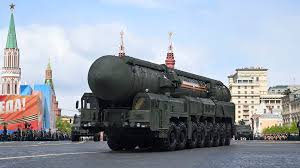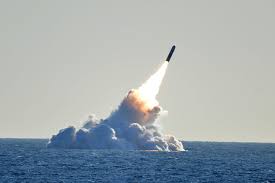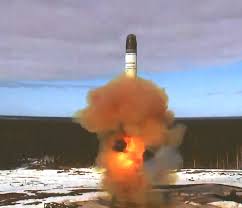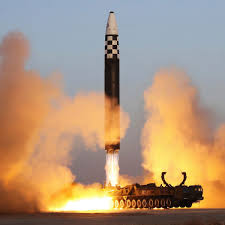A nuclear missile launch is one of the most consequential and tightly controlled events in modern warfare. Unlike conventional missile launches, a nuclear missile carries a warhead capable of causing massive destruction, long-term environmental damage, and significant geopolitical consequences. Understanding how nuclear missile launches work, the systems behind them, and the global safety measures in place is essential for anyone interested in international security, defense technology, or global policy.
The process of a nuclear missile launch is highly complex and involves multiple levels of authorization, technological precision, and safety protocols designed to prevent accidental detonations or unauthorized strikes. Countries with nuclear capabilities maintain strict command-and-control systems to ensure that every launch is deliberate and accountable. These systems include launch codes, communication networks, and fail-safe mechanisms, making nuclear launches distinct from conventional military operations.
In this article, we will explore every aspect of a nuclear missile launch, including the different types of nuclear missiles, launch systems, historical examples, potential consequences, and the regulations and safety measures that govern them. We will also discuss emerging technologies, cybersecurity concerns, and the future of nuclear deterrence. By the end, readers will have a deep and comprehensive understanding of one of the most critical topics in modern global security.
What Is a Nuclear Missile Launch?

A nuclear missile launch refers to the controlled firing of a missile equipped with a nuclear warhead. Unlike conventional missiles, nuclear missiles are designed to deliver explosive power that can devastate entire cities, cause long-term environmental damage, and shift geopolitical balances. These weapons are considered strategic assets and are tightly controlled to prevent unauthorized or accidental use.
The primary purpose of a nuclear missile launch is either deterrence or, in extreme scenarios, strategic attack. Countries with nuclear capabilities rely on the threat of a potential nuclear strike to prevent conflicts—a concept known as Mutually Assured Destruction (MAD). The idea is simple but profound: no nation will launch a nuclear attack if it knows that retaliation will result in its own destruction.
Key differences between nuclear and conventional missile launches include:
- Payload: Nuclear missiles carry highly destructive warheads capable of releasing energy equivalent to thousands or even millions of tons of TNT, while conventional missiles carry explosives designed for tactical targets.
- Range: Nuclear missiles often include intercontinental ballistic missiles (ICBMs) that can travel thousands of miles to reach strategic targets, whereas conventional missiles are typically shorter-range.
- Launch Protocols: Nuclear launches require strict authorization codes, multi-layered verification, and secure communication networks, whereas conventional missile launches have less stringent protocols.
- Global Impact: The consequences of a nuclear missile launch are global, affecting international politics, economies, and human populations.
Types of Nuclear Missile Launches:
- Strategic Launch: Involves long-range missiles targeting other nations or military assets.
- Tactical Launch: Shorter-range missiles intended for battlefield use, minimizing widespread collateral damage.
- Test Launch: Controlled tests to verify missile accuracy, propulsion systems, and warhead functionality.
Fact: According to the Federation of American Scientists, there are currently over 12,500 nuclear warheads worldwide, with several thousand actively deployed on missiles capable of global reach. This underscores the importance of understanding nuclear missile launch protocols and safeguards.
In essence, a nuclear missile launch is not just a technical procedure; it is a high-stakes decision with the potential to shape the course of international relations, national security, and human survival.
Types of Nuclear Missiles and Launch Systems
Understanding the different types of nuclear missiles and their launch systems is critical to grasp how a nuclear missile launch works and why various strategies exist for deterrence and defense. Each missile type serves a unique purpose, from long-range strategic strikes to tactical battlefield applications.
Intercontinental Ballistic Missiles (ICBMs)
ICBMs are long-range missiles designed to carry nuclear warheads across continents. They are a cornerstone of global nuclear deterrence because of their ability to strike targets thousands of miles away.
Key Features:
- Range: 5,500 km (3,400 miles) or more.
- Payload: One or multiple nuclear warheads (MIRVs – Multiple Independently targetable Reentry Vehicles).
- Launch Platforms: Silo-based or road-mobile systems.
- Accuracy: Equipped with advanced guidance systems for precise targeting.
Example: The U.S. Minuteman III ICBM and Russia’s RS-24 Yars are modern examples of deployed ICBMs.
Strategic Importance: ICBMs ensure that even if a country’s cities or military bases are attacked, it can retaliate, maintaining the concept of Mutually Assured Destruction (MAD).
Submarine-Launched Ballistic Missiles (SLBMs)
SLBMs are nuclear missiles launched from submarines, providing stealth, mobility, and survivability.
Key Features:
- Platform: Nuclear-powered submarines submerged underwater.
- Stealth Advantage: Hard to detect, making them difficult to preemptively neutralize.
- Payload: Typically carries a single or multiple nuclear warheads.
- Range: Similar to ICBMs, often exceeding 7,000 km.
Strategic Importance: SLBMs form the second-strike capability, meaning a country can retaliate even if its land-based missiles are destroyed.
Example: The U.S. Ohio-class submarines and Russia’s Borei-class submarines carry SLBMs capable of global reach.
Tactical Nuclear Missiles
Unlike strategic missiles, tactical nuclear missiles are designed for shorter ranges and limited targets, often on the battlefield.
Key Features:
- Range: Typically under 300 km.
- Purpose: Target military bases, troop formations, or critical infrastructure without massive civilian casualties.
- Platforms: Can be launched from ground-based systems, aircraft, or smaller naval vessels.
Example: Russia’s Iskander missile system and U.S. tactical missile programs.
Strategic Importance: They offer flexibility and deterrence in regional conflicts, complementing long-range nuclear arsenals.
Mobile Launch Platforms
Mobility adds an extra layer of security and unpredictability to nuclear deterrence. Mobile platforms include:
- Road-mobile ICBMs: Transported on trucks or trailers, making them difficult to locate and target.
- Rail-based Systems: Trains equipped with missile silos can move across tracks to evade detection.
- Airborne Platforms: Missiles launched from aircraft or drones, though less common, add strategic versatility.
Benefit: Mobility complicates enemy planning and enhances survivability of nuclear assets during potential conflicts.
Summary Table: Types of Nuclear Missiles
| Missile Type | Range | Platform | Strategic Use |
|---|---|---|---|
| ICBMs | 5,500+ km | Silo/mobile | Long-range strategic strikes |
| SLBMs | 7,000+ km | Submarine | Stealth second-strike capability |
| Tactical Nuclear Missiles | <300 km | Ground/air/naval | Battlefield or regional deterrence |
| Mobile Launch Platforms | Varies | Road, rail, air | Survivability and unpredictability |
Key Takeaways:
- Nuclear missile types are designed for different purposes, from global deterrence to battlefield flexibility.
- Mobile and submarine-launched systems increase survivability and make preemptive strikes difficult.
- Understanding the types of nuclear missiles is essential to grasp the mechanics and strategic importance of a nuclear missile launch.
How a Nuclear Missile Launch Works

A nuclear missile launch is a tightly controlled sequence that combines human decision‑making, secure communications, and sophisticated engineering. While the exact procedures vary by country and platform (silo, submarine, mobile launcher), the broad elements are the same: authorization, command & control, weapon preparation, launch execution, and flight phases. Each of these elements is governed by layers of safeguards intended to prevent accidental or unauthorized use and to ensure command responsibility in crisis conditions.
Authorization and Command Chain (High‑Level)
At the heart of any nuclear missile launch is the authorization process. Most nuclear‑armed states maintain a clear legal and operational chain of command that identifies who may order a launch (for example, a head of state or designated national authority) and how that order is authenticated. Important high‑level features include:
- Single ultimate authority: A designated national leader (e.g., president, prime minister) typically holds ultimate launch authority in wartime.
- Verification layers: Orders are verified through secure channels and coded authentications; specialized command centers receive and confirm directives.
- Two‑person / dual control principles: Many systems require two or more authorized personnel to concur before certain critical actions can proceed—this reduces the risk of unilateral or accidental action.
- Legal and political checks: Constitutional and legislative frameworks, plus military protocols and ministerial inputs, shape how and when a launch decision is taken.
Important: Public descriptions generally stop at the conceptual level for good reason—revealing operational specifics or procedural workarounds could create security risks. The goal here is to explain the why and what, not provide operational instructions.
Command, Control, Communications and Safeguards
Effective command-and-control (C2) systems let leaders reach forces anywhere in the world and ensure orders are authentic. Components and safeguards typically include:
- Hardened command centers: Protected facilities (often dispersed) that survive attacks and maintain continuity of government and military control.
- Secure communication lines: Redundant, encrypted channels (satellite, radio, landlines) to transmit authenticated orders.
- Permissive access controls: Technical safeguards (e.g., coded locks, cryptographic systems) that prevent unauthorized arming or firing of warheads.
- Fail‑safe measures: Design features that default to safe states or require positive confirmation before arming.
- Early‑warning integration: Radar and satellite early‑warning systems feed data to command centers so decision‑makers have situational awareness.
These layers are meant to prevent accidental launches, reduce the risk of unauthorized launches, and enable leaders to make informed decisions rapidly during crises.
Launch Procedures (Conceptual, Non‑Actionable)
While we won’t provide procedural steps or operational details, here’s the conceptual flow from an authorized decision to a missile leaving its launcher:
- Decision & Order: The authorized national leader decides and issues an authenticated order via secure channels.
- Authentication: Command centers validate the order using cryptographic and procedural checks.
- Weapons Status Check: Systems report readiness (fuel, targeting data, safety interlocks). Human operators perform permitted checks.
- Arming/Preparation: If authorized, arming sequences (often tightly restricted) proceed under strict control and multi‑person oversight.
- Launch Execution: The missile is launched from its platform (silo, submarine launch tube, mobile erector) and begins its powered flight phases.
Again, this is the conceptual flow—public discussion focuses on safeguards, legal authority, and the high‑level steps because detailed operational steps are sensitive.
Flight Phases of a Nuclear Missile (Technical, Non‑Actionable)
A launched ballistic missile goes through distinct flight phases. These phases are useful for understanding detection timelines, interception possibilities, and the physics involved:
| Phase | Description | Typical Duration / Notes |
|---|---|---|
| Boost | Rocket engines fire, propelling the missile away from its launcher and accelerating it into space. | Minutes (varies by missile type). This is an energetically intense, short phase. |
| Midcourse | Missile (or its reentry vehicles) coasts through space along a ballistic trajectory. | Tens of minutes for ICBMs (this is where decoys or countermeasures may separate). |
| Reentry / Terminal | Warhead(s) reenter the atmosphere and home toward the target using heat‑shielding and guidance. | Minutes — last chance for interception by missile‑defense systems; effects occur on impact. |
Example timeline: A typical ICBM launched from one continent to another may take roughly 20–40 minutes from launch to impact, depending on range and trajectory. That short window has major implications for decision‑making and defense.
Guidance, Targeting and Accuracy (High‑Level)
Nuclear missiles rely on guidance systems (inertial navigation, stellar/terrain updates, satellite aids) to reach targets with varying accuracy. Modern missiles may carry MIRVs (multiple independently targetable reentry vehicles), allowing one missile to strike multiple targets. Accuracy is described by CEP (Circular Error Probable)—the radius within which a percentage of warheads are expected to fall—but exact CEP figures are sensitive and vary by system.
Detection, Early Warning, and Response
A network of satellites, radars, and sensors monitors for missile launches and trajectories. Key points:
- Early‑warning satellites detect heat signatures from rocket plumes.
- Ground and sea radars track descending objects and predict impact points.
- Time to decision for national leaders is constrained by detection speed and missile flight time; shorter flight times compress the decision window.
- Defense layers (boost‑phase, midcourse, terminal interceptors) have theoretical roles, but each has significant technical limitations and political implications.
These systems aim to provide leaders both warning and options (diplomacy, alerting forces, missile defenses), but they also increase crisis pressure because rapid, high‑stakes decisions may be required.
Safeguards Against Accidental or Unauthorized Launch
Given catastrophic consequences, multiple safeguards exist to reduce the likelihood of accidental or unauthorized launches:
- Redundant authentication: Multi‑factor orders and coded confirmations.
- Two‑person rules: Critical actions require concurrence of at least two authorized personnel.
- Environmental monitoring: Systems flag anomalous readings that could indicate false positives (e.g., satellite glitch).
- Training and drills: Regular exercises to test procedures, while maintaining strict control over live weapons.
- Physical protections: Hardened silos, protected submarines, and controlled access to launch systems.
The overall architecture emphasizes both survivability (so deterrence remains credible) and restraint (so accidents are prevented).
Cybersecurity and Modern Threats (Overview)
Modern command and control systems face evolving cyber threats. High‑level concerns and responses include:
- Threats: Malware, data manipulation, denial of service, and attempts to spoof sensor feeds could disrupt decision cycles or create false alarms.
- Defenses: Air‑gapped systems, multi‑layer encryption, rigorous access controls, continuous monitoring, and oversight by human operators.
- Policy implications: Nations balance the need for secure, rapid decision‑making with protections against cyber intrusion and misinformation.
Security of digital systems is as critical as the physical safeguards because vulnerabilities could erode the reliability of early‑warning data or communication links.
Ethical, Legal and Strategic Constraints
A nuclear missile launch is not merely a military action; it is governed by legal, ethical, and strategic frameworks:
- International law and norms: Use of nuclear weapons raises profound questions under international humanitarian law (proportionality, civilian protection) and global norms against mass destruction.
- Deterrence theory: Nuclear launches are tied into doctrines like first use, no first use, and second strike, which influence posture and political signaling.
- Escalation risk: Any launch risks rapid escalation—and thus decision‑makers evaluate not just immediate military effects but cascading political consequences.
Understanding these frameworks helps explain why nations emphasize strict control, transparency (where possible), and arms‑control diplomacy.
Summary — Why the Process Matters
A nuclear missile launch sits at the intersection of technology, policy, and human judgment. The tight web of authorization rules, command‑and‑control safeguards, detection systems, and legal constraints exists precisely because the consequences of error—or intentional misuse—are so severe. For readers, the takeaway is clear: while the mechanics and physics are important, the political, ethical, and procedural controls are what make nuclear arsenals survivable tools of deterrence rather than uncontrollable existential threats.
Historical Nuclear Missile Launches

Understanding historical nuclear missile launches provides valuable context for how nations have developed, tested, and managed their nuclear arsenals. These events illustrate the evolution of launch technology, command protocols, and the geopolitical consequences of nuclear weapons.
Early Nuclear Missile Tests
After World War II, the United States and the Soviet Union began developing nuclear missiles as part of the arms race. These tests were not operational launches against targets but experimental firings to validate technology, range, and payload accuracy.
- U.S. Tests:
- Redstone and Atlas missiles tested in the 1950s.
- First operational ICBM: Atlas F (1962).
- Soviet Tests:
- R-7 Semyorka, first ICBM (1957).
- Purpose: Demonstrate range, reliability, and strategic capability.
These early tests set the stage for long-range nuclear deterrence and formed the basis of missile defense considerations for decades.
Cold War Launches and Crises
The Cold War era saw the most significant nuclear missile stand-offs between the U.S. and USSR. While there were no combat launches, several crises brought the world to the brink of nuclear war.
- Cuban Missile Crisis (1962):
- The Soviet Union placed nuclear missiles in Cuba, leading to a 13-day standoff.
- Key Lesson: Command and communication protocols were tested, and rapid decision-making under high tension highlighted the risk of accidental or misinterpreted launches.
- Alert Levels:
- Both nations increased the readiness of ICBMs and bombers.
- Submarines armed with SLBMs were deployed, forming part of second-strike capabilities.
Quote: President John F. Kennedy described the crisis as “the most dangerous moment in human history,” emphasizing the high stakes of nuclear missile readiness.
Nuclear Tests by Other Nations
As nuclear technology proliferated, other countries developed nuclear missiles to enhance regional deterrence:
- India and Pakistan: Conducted nuclear tests in 1998, developing short- and medium-range missiles for regional defense.
- North Korea: Repeated tests since 2006, including ICBM launches capable of intercontinental reach, causing international concern.
- France and China: Conducted missile tests in the 1960s–1980s to secure strategic deterrence.
These launches primarily served to validate missile systems, ensure reliability, and signal strategic capability to other nations.
Accidental or False Alarm Incidents
Several near-miss incidents highlight the importance of safeguards and early-warning systems:
- 1983 Soviet False Alarm Incident:
- A satellite incorrectly reported incoming U.S. missiles.
- Stanislav Petrov, a Soviet officer, chose not to report it as an attack, preventing a potential nuclear launch.
- 1961 Goldsboro Incident (U.S.):
- A B-52 bomber broke apart over North Carolina, accidentally dropping two nuclear bombs.
- Safety mechanisms prevented detonation, but it revealed the risks inherent in handling nuclear weapons.
These cases demonstrate why safeguards, verification protocols, and human judgment are critical components of the nuclear missile launch process.
Key Lessons from History
- Deterrence Works: The threat of nuclear retaliation has historically prevented full-scale nuclear conflict.
- Technology is Not Foolproof: Malfunctions, human error, and miscommunication have almost caused unintended escalation.
- Safeguards Save Lives: Protocols, verification systems, and early-warning networks are essential to prevent accidental launches.
- Global Awareness is Vital: International treaties, inspections, and diplomacy play key roles in managing nuclear risk.
Timeline Table: Selected Key Nuclear Missile Launch Events
| Year | Country | Event | Notes |
|---|---|---|---|
| 1957 | USSR | R-7 ICBM Test | First successful long-range ICBM |
| 1962 | USA/Soviet Union | Cuban Missile Crisis | High-alert standoff, no launches |
| 1983 | USSR | False Alarm Incident | Human judgment prevented launch |
| 1998 | India/Pakistan | Nuclear Tests | Regional deterrence established |
| 2006–2020 | North Korea | ICBM Tests | Global concern, advanced missile capability |
Key Takeaways:
- Historical nuclear missile launches highlight both technological advancement and geopolitical risk.
- Crises, tests, and near-miss incidents underline the importance of launch protocols, safeguards, and human decision-making.
- Understanding history helps contextualize modern nuclear strategy and the ongoing importance of international treaties and monitoring.
Consequences of a Nuclear Missile Launch
A nuclear missile launch has consequences that extend far beyond the immediate impact of the explosion. The effects can be human, environmental, economic, and geopolitical, making it one of the most dangerous military actions possible. Understanding these consequences is critical for appreciating why nuclear weapons are tightly controlled and heavily regulated.
Immediate Effects
When a nuclear missile detonates, the immediate effects are catastrophic:
- Blast and Shockwave
- The explosion generates a massive shockwave capable of destroying buildings, infrastructure, and military installations within kilometers.
- For large warheads, cities can be leveled almost instantly.
- Thermal Radiation
- The fireball produces extreme heat, causing severe burns and igniting fires across a wide area.
- The thermal pulse can trigger secondary fires over tens of kilometers, creating firestorms in urban centers.
- Initial Radiation
- Neutrons and gamma rays are emitted at the moment of detonation, causing acute radiation sickness for anyone nearby.
- This radiation can be lethal within minutes to hours, depending on distance and yield.
Fact: The Hiroshima bomb (15 kilotons) killed an estimated 70,000–80,000 people instantly, with tens of thousands more dying later from radiation exposure.
Long-Term Environmental and Health Effects
Beyond immediate destruction, a nuclear missile launch can cause long-term consequences that affect human health, ecosystems, and the climate:
- Radioactive Fallout
- Particles from the explosion are carried by wind, contaminating land, water, and food sources far from the blast zone.
- Fallout can remain hazardous for decades, causing cancers and genetic mutations.
- Environmental Contamination
- Soil and water contamination disrupts agriculture and local economies.
- Forests, rivers, and ecosystems can take decades to recover.
- Nuclear Winter (Hypothetical Large-Scale Conflict)
- Multiple nuclear detonations could inject soot and dust into the atmosphere, blocking sunlight.
- This could lower global temperatures, disrupt agriculture, and trigger mass famine—a phenomenon known as nuclear winter.
Geopolitical Consequences
A nuclear missile launch also has profound implications for global politics:
- International Relations and Escalation
- Any nuclear strike could trigger retaliation, alliances activating, or full-scale war.
- The doctrine of Mutually Assured Destruction (MAD) ensures that even a single launch risks escalation to catastrophic global conflict.
- Diplomatic Fallout
- A nuclear strike undermines treaties and norms, eroding trust between nations.
- Economic sanctions, isolation, and military responses often follow aggressive nuclear actions.
- Global Security Concerns
- Countries may accelerate their own nuclear programs or defense systems.
- Increased militarization and arms races heighten the probability of accidental or deliberate conflict.
Economic and Social Consequences
The fallout from a nuclear missile launch also extends to societies and economies:
- Infrastructure Loss: Entire cities or military bases can be destroyed, disrupting transportation, utilities, and communications.
- Humanitarian Crisis: Millions may require medical aid, food, and shelter, overwhelming governments and NGOs.
- Global Markets: Financial markets react negatively, global trade can be disrupted, and reconstruction costs can reach hundreds of billions.
Case Study: Even during Cold War simulations, economists estimated that a limited nuclear strike on a regional power could result in trillions of dollars in economic damage worldwide, showing the ripple effect of even a “small-scale” launch.
Summary Table: Consequences of a Nuclear Missile Launch
| Consequence Type | Description |
|---|---|
| Immediate | Blast, thermal radiation, initial radiation causing massive casualties |
| Long-Term Environmental | Radioactive fallout, soil & water contamination, potential nuclear winter |
| Geopolitical | Retaliation risk, global escalation, treaty violations |
| Economic | Infrastructure loss, trade disruption, reconstruction costs |
| Social | Humanitarian crises, displacement, long-term health impacts |
Key Takeaways:
- The effects of a nuclear missile launch are both immediate and long-term, spanning human, environmental, economic, and political domains.
- Even a single missile strike can destabilize entire regions and affect global security.
- Understanding these consequences underscores why nations maintain strict launch protocols and international safeguards.

Conclusion
A nuclear missile launch is one of the most consequential events in modern military and geopolitical history. It combines advanced technology, strategic decision-making, and rigorous safeguards to manage weapons capable of unparalleled destruction. From the authorization protocols and complex command-and-control systems to the types of missiles, launch platforms, and historical incidents, understanding the full scope of a nuclear missile launch is essential for appreciating both its strategic importance and the profound risks it carries.
The consequences of a nuclear missile launch extend far beyond the immediate blast. They include long-term environmental contamination, humanitarian crises, economic disruption, and global political instability. Historical events, near-misses, and international incidents highlight the importance of stringent safety measures, early-warning systems, and international treaties. Organizations such as the United Nations, the International Atomic Energy Agency (IAEA), and various arms control agreements play critical roles in preventing accidental or unauthorized launches and ensuring global security.
Emerging technologies, such as hypersonic missiles, artificial intelligence, and cybersecurity systems, are reshaping how nations approach nuclear deterrence. While these advancements improve accuracy and survivability, they also increase the stakes, making oversight, diplomacy, and responsible governance more important than ever.
In conclusion, a nuclear missile launch is not merely a military procedure—it is a high-stakes convergence of technology, politics, and human judgment. Understanding its mechanics, history, and consequences is vital for informed discussions about global security, international relations, and the future of nuclear deterrence.



